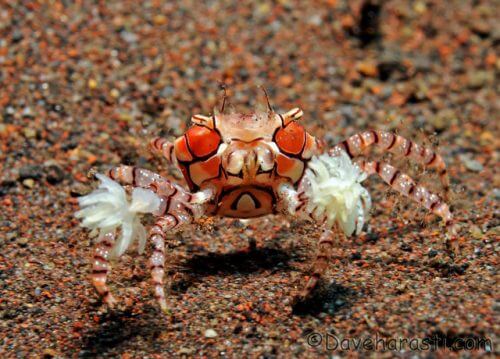In memory of the boxer Muhammad Ali who died in June this year, this month's organism is a creature that uses its fists to deter predators. It is not a large, muscular animal, but rather a small crab, which makes effective use of another creature's defenses for its protection

By: Adi Weiss
The boxer crab (Lybia tessellate; also called pom pom crab, boxer crab, and even cheerleader crab) is a delicate and quite colorful crab, whose size usually does not exceed 2.5 cm. It is common along the coasts of the Red Sea, along the east coast of Africa, as well as on the coasts of Indonesia, Papua New Guinea, Australia and Madagascar, where tropical waters are warm. It lives in rock crevices, in places where it is difficult for large predators to enter. However, when threatened it has an extremely effective local weapon - it holds the power of a tiny sea lily in each of its tombstones. The poisonous arms of the rose are directed towards the threat, and its stinging cells provide the crab with an effective defense against predators.
The relationship between the Cancer and the Sea Lily works as a successful collaboration. The sea lily can indeed live close to rocks, in colonies, but it also thrives in the arms of the crab, which never leaves it for a moment - except during moulting.
Observations show that the crab prefers three types of sea anemone, two of which are known to have a strong venom in relation to their size, but without a choice it will replace its preferred weapons with sponges or corals. His front pincers, which in his relatives (the Xanthidae family) are meant to tear off pieces of food and put them in his mouth, have been shaped in the course of evolution into stubborn pincers, which cannot tear leftover food into pieces and are only meant to hold the sea anemone. Instead of the front pair of pincers, the second pair of his legs developed into such pincers.
When eating, the crab sea lily is also used as an occasional napkin; He waves them around his mouth and collects the leftover food that was thrown out while eating. The scraps stick to the sea urchin's arms, and he can scoop them up into his mouth efficiently. The sea lily benefits both from the meal and from its energetic partner. Instead of waiting for organic matter in one place, the sea lily can collect particles floating in the water column while the crab wanders.
Despite the elegant solution and being relatively common and familiar, few studies have been done on the boxer cancer. Are there other amazing strategies in his arsenal? We'll have to wait and find out.

One response
Interesting but:
The time has come for the translators to learn and internalize the difference between: species and species
originally species sects meaning species,
Why does the translator write type?